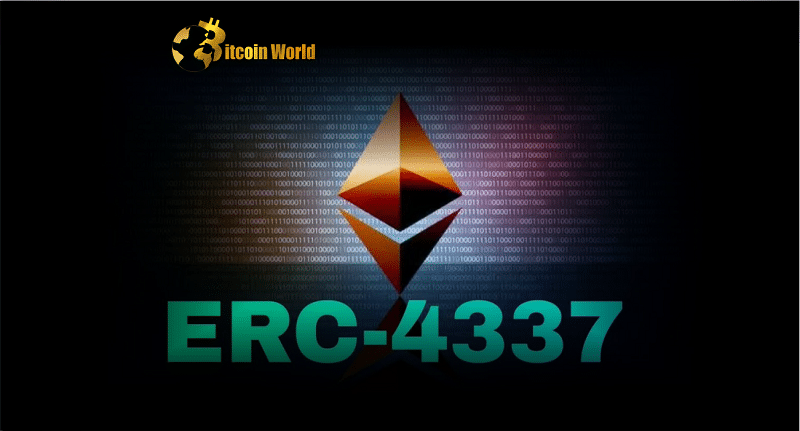Have you ever wished your crypto wallet was more powerful, flexible, and user-friendly? Well, the future is here, and it’s called Account Abstraction on Ethereum, made possible by the groundbreaking ERC-4337 standard. Launched on the Ethereum mainnet on March 1st, this isn’t just a minor upgrade; it’s a fundamental shift in how we interact with decentralized applications (dApps) and manage our digital assets. Think of it as adding a sophisticated new layer to Ethereum, specifically designed to supercharge your crypto experience through what are known as smart accounts.
What Exactly is Account Abstraction and Why Should You Care?
For a while now, smart contract wallets have existed, offering more features than your standard Ethereum wallet. However, they often relied on centralized components, which kind of defeats the purpose of decentralization, right? ERC-4337 changes the game by introducing a truly decentralized infrastructure for these enhanced wallets. It does this by establishing a distributed network of key players: Bundlers and Paymasters.
Matt Cutler, co-founder and CEO of Blocknative, a leading Ethereum infrastructure provider, highlights that ERC-4337 brings with it a significant, though subtle, change: the introduction of the “User Intent Layer.” To understand this, let’s quickly break down how a typical Ethereum transaction works today:
- Transaction Creation: You, the user, use your regular Ethereum wallet, known as an Externally-Owned Account (EOA), and your private key to create and sign a transaction. Imagine you’re sending an NFT to a friend.
- Mempool Entry: This signed transaction enters the public mempool. Think of the mempool as a waiting room for transactions, a shared space where all pending transactions hang out.
- Block Building: A “Builder” picks up transactions from the mempool and organizes them into a block that is profitable for miners/validators.
- Validation and On-chain Execution: A Validator proposes this block, and if validated by the network, it’s added to the blockchain, and your transaction is complete.
Now, where does the “User Intent Layer” fit in? It’s inserted right at the beginning, before the EOA step in the traditional process. This is where the magic of ERC-4337 really begins to unfold.
The User Intent Layer: Unlocking Complex Transactions
This new layer empowers you to initiate much more complex actions with a single, user-friendly step. How? ERC-4337 introduces an “Alternative Mempool” (Alt-Mempool) and a network of Bundlers. This Alt-Mempool is where “User Operations” (userOps) reside. UserOps are essentially requests from smart accounts outlining what they want to achieve.
Let’s delve deeper into the role of Bundlers:
Bundlers: The Architects of User Intent
A Bundler node plays a role similar to the block “Builder” in the traditional Ethereum process, but with a crucial difference. Instead of picking signed transactions from the public mempool, a Bundler:
- Grabs User Operations (userOps) from the Alt-Mempool.
- Creates Profitable Bundles: Bundlers organize these userOps into the most profitable bundle they can create, much like Builders create profitable blocks.
- Submits to Network: This bundle is then signed and submitted to the Ethereum network as a single transaction.
This bundling process is the core of the new layer that enables smart accounts to function in a decentralized manner. Bundlers are essential for processing user intents expressed through smart accounts.
Are Bundlers Just “Set It and Forget It” Money Printers?
While theoretically, anyone can become a Bundler, Matt Cutler cautions that being a *successful* Bundler is a different story altogether. Bundlers, like Builders, are specialized actors. They require:
- Sophisticated Development Teams: Operating a Bundler effectively needs technical expertise.
- Significant Infrastructure: Bundlers rely on substantial computational power, storage, and networking infrastructure to operate competitively.
Cutler emphasizes, “ERC-4337 is permissionless and trustless. So, if you’re technically inclined, you absolutely can set up and run your own Bundler. The challenge lies in the highly competitive nature of bundling. You’ll be up against teams that are heavily invested in optimizing their Bundler operations.”
In essence, Bundling isn’t a passive income stream. It’s an active, technically demanding role. As Cutler notes, “Bundlers are not the type of tooling you set up, forget about, and it starts printing money for you. We anticipate Bundling to be far more technically sophisticated than being a validator.” However, for those interested in diving in, the good news is that there are already numerous open-source bundler code repositories available to explore.
Impact on Ethereum Gas Fees: Will ERC-4337 Make Things More Expensive?
The question on everyone’s mind: Will this new User Intent Layer and the introduction of smart accounts make Ethereum transactions even more expensive? The impact of ERC-4337 on gas fees is still a topic of ongoing discussion. Given the increased complexity of transactions with the User Intent Layer, it’s a valid concern.
However, Cutler offers a reassuring perspective: “While it’s still early days, my current expectation is that gas prices, on average, will not change dramatically. If ERC-4337 has any noticeable effect, it will likely be minor – either slightly up or slightly down. We certainly don’t foresee transaction fees vanishing or suddenly becoming 100 times more expensive overnight.”
In Conclusion: Account Abstraction – A Step Towards a More User-Friendly Ethereum
ERC-4337 and Account Abstraction represent a significant leap forward for Ethereum. By introducing the User Intent Layer and decentralized smart accounts, Ethereum is paving the way for:
- More Powerful Wallets: Smart accounts offer enhanced functionality, customization, and improved user experience.
- Simplified Complex Transactions: Users can initiate intricate actions with greater ease.
- Decentralized Infrastructure: ERC-4337 ensures a trustless and permissionless environment for smart accounts.
While the Bundler ecosystem is still developing and requires technical expertise to participate competitively, the overall impact of Account Abstraction is poised to be positive. It’s a crucial step towards making Ethereum more accessible and user-friendly for everyone, ultimately driving wider adoption of decentralized technologies.
Disclaimer: The information provided is not trading advice, Bitcoinworld.co.in holds no liability for any investments made based on the information provided on this page. We strongly recommend independent research and/or consultation with a qualified professional before making any investment decisions.


